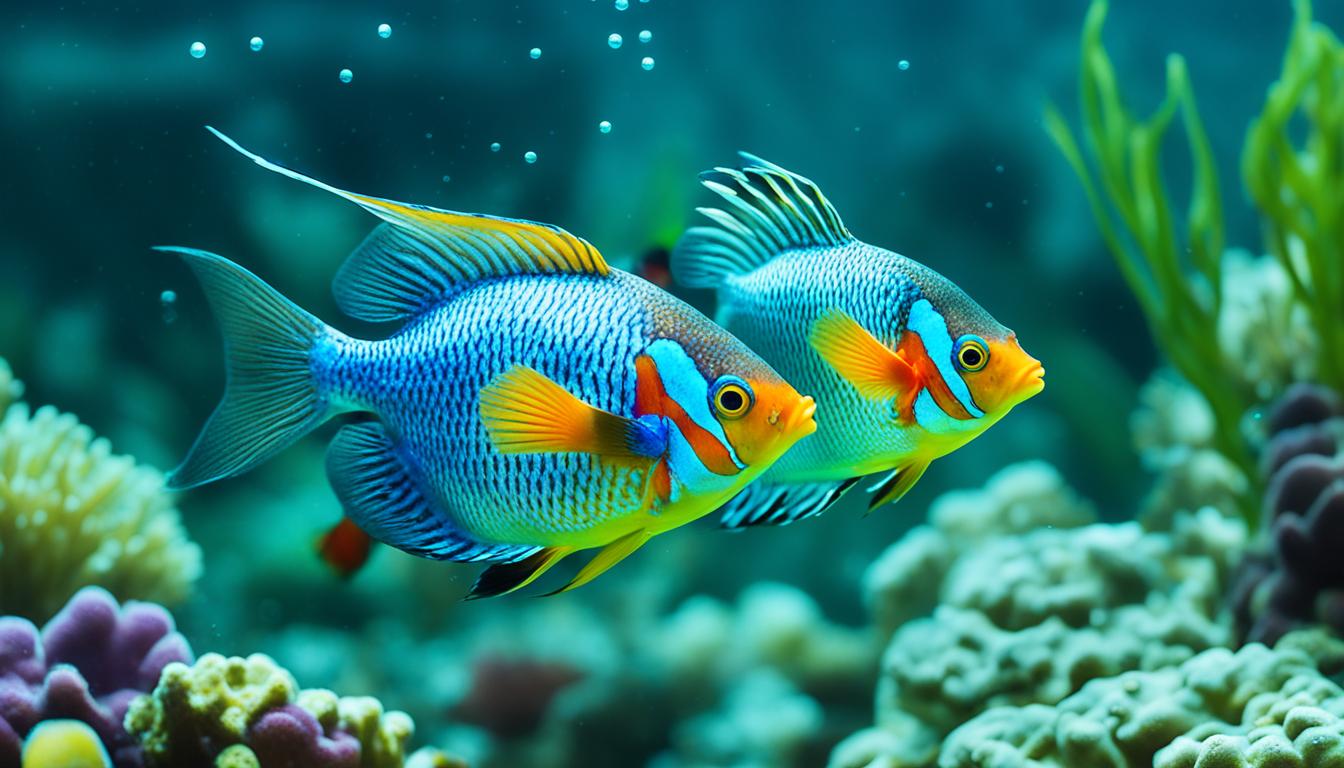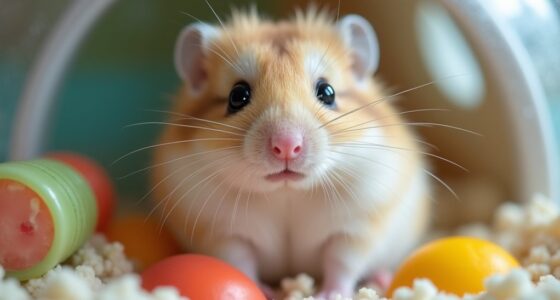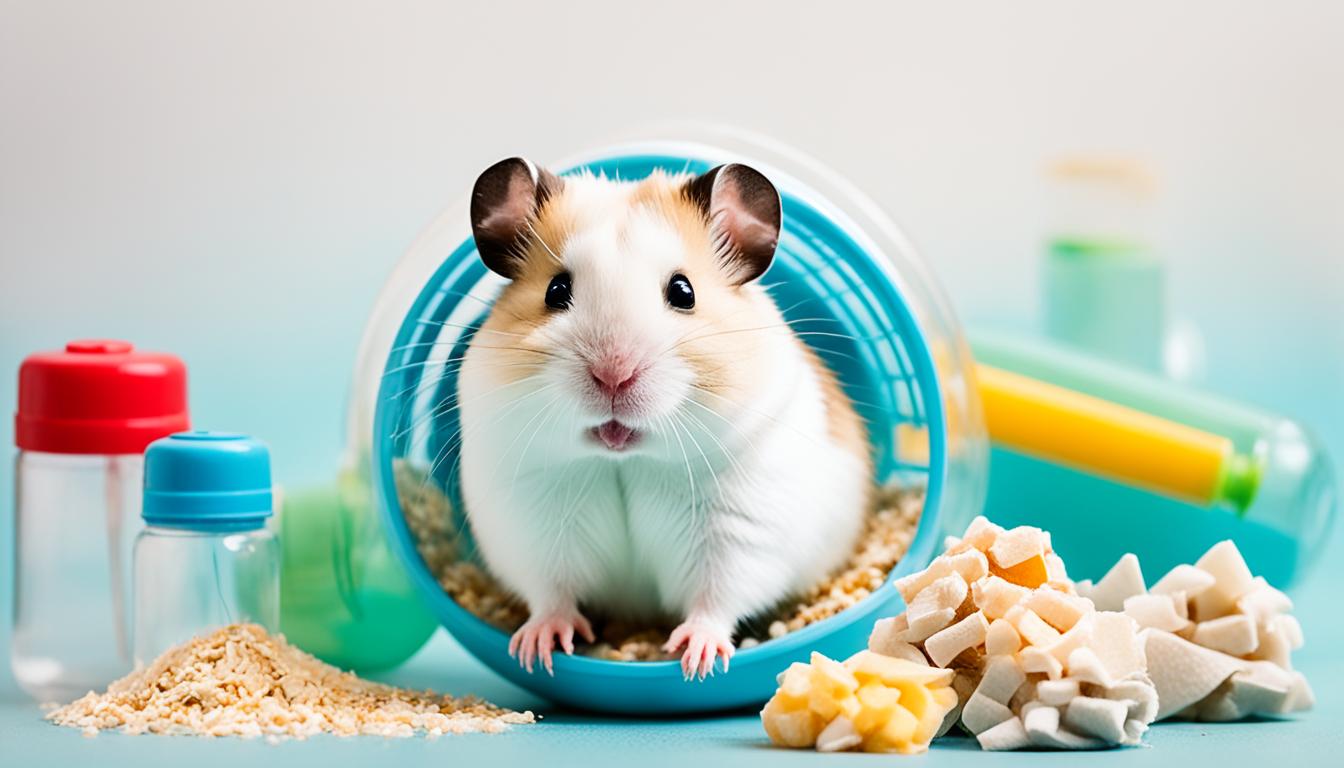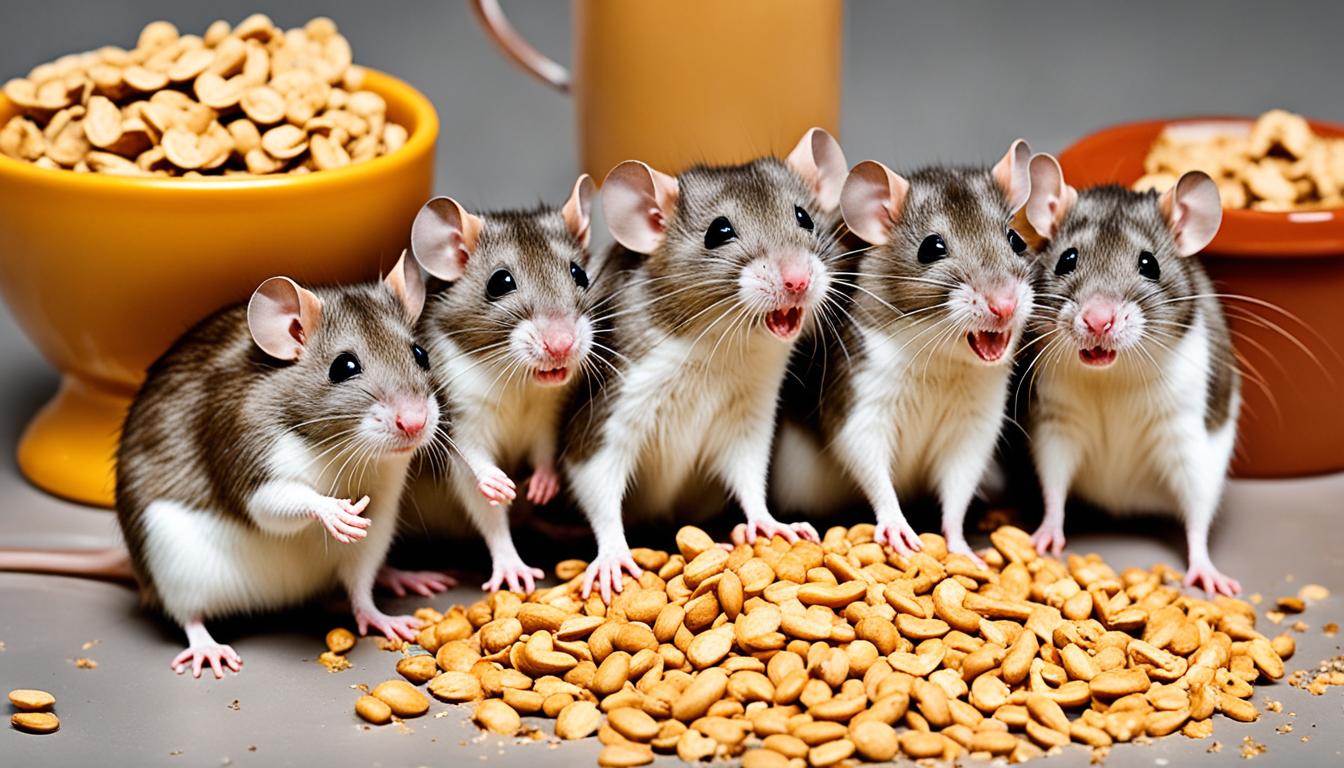Did you know that hamsters have a diverse diet and can enjoy a variety of vegetables? One vegetable that may come as a surprise is zucchini. Yes, hamsters can indeed eat zucchini as part of their safe and nutritious diet! This versatile vegetable is not only low in calories but also rich in antioxidants and packed with essential vitamins, making it an excellent snack choice for our little furry friends.
When it comes to feeding zucchini to your hamster, it’s essential to understand the proper guidelines and portion sizes to ensure their overall health and well-being. Let’s dive deeper into the world of hamster nutrition and explore how zucchini can be a safe and tasty addition to their diet.
Key Takeaways:
- Zucchini is a safe and nutritious snack for hamsters.
- It is low in calories, rich in antioxidants, and contains vitamins A, C, and K.
- Zucchini should be given in moderation and as a supplemental snack.
- Monitor your hamster for any signs of an upset stomach when introducing zucchini.
- Follow the recommended feeding guidelines and consult a veterinarian if needed.
Hamster Diet Basics
A hamster’s diet should consist of a well-balanced mix of nutrition. While hamsters primarily eat pellets, adding small amounts of vegetables, such as zucchini, can provide additional nutritional benefits. It is important to ensure that the majority of the hamster’s diet comes from high-quality pellets that meet their nutritional needs, and vegetables should only be given as supplemental snacks. Zucchini, being low in calories and rich in nutrients, can be a healthy addition to a hamster’s diet.
Hamsters require a diverse diet to thrive and maintain good health. Pellets formulated specifically for hamsters contain the necessary nutrients for their well-being, including protein, carbohydrates, fat, vitamins, and minerals. These pellets should form the foundation of your hamster’s diet, making up the majority of their daily intake.
While pellets are essential, incorporating vegetables into your hamster’s diet can offer additional nutritional benefits. Vegetables like zucchini provide vitamins and minerals that support your hamster’s overall well-being. In particular, zucchini is low in calories, which is important for preventing excessive weight gain in hamsters. It also contains essential nutrients, including vitamins A and C.
| Nutrients Found in Zucchini | Amount |
|---|---|
| Vitamin A | Provides antioxidants and promotes healthy eyesight |
| Vitamin C | Supports the immune system and overall health |
| Dietary Fiber | Aids in digestion and prevents constipation |
It is important to note that vegetables should only comprise a small portion of your hamster’s diet. The bulk of their nutrition should come from high-quality pellets. It is also crucial to introduce vegetables gradually, starting with small amounts to allow your hamster’s digestive system to adjust. This will help prevent any digestive upset.
Quote: “Adding vegetables like zucchini to your hamster’s diet can provide a wide range of essential nutrients that contribute to their overall health and well-being.” – Dr. Emily Anderson, Small Animal Veterinarian
By offering your hamster a well-balanced diet that includes nutritious pellets and small amounts of vegetables like zucchini, you can ensure they receive the necessary nutrients for optimal health. Remember to monitor your hamster for any changes in their overall well-being and consult with a veterinarian if you have any concerns about their diet.

How Much Zucchini to Feed Your Hamster
When it comes to feeding zucchini to your hamster, it’s important to consider the portion size. A healthy hamster diet consists of a balanced mix of carbohydrates, protein, and fat. While high-quality hamster pellets meet most of their nutritional needs, zucchini can be added as a small piece a few times a week, alongside other vegetables.
To maintain a well-rounded hamster diet, it’s recommended to avoid feeding zucchini to your hamster two consecutive days in a row. Instead, rotate it with other vegetable options to provide variety. Gradually increase the portion size of zucchini for subsequent feedings to gauge your hamster’s tolerance and preference.
Here’s a breakdown of a healthy hamster diet proportion:
| Carbohydrates | Protein | Fat |
|---|---|---|
| 35-40% | 15-25% | 4-5% |
Remember, a diverse diet that includes zucchini as a supplemental snack ensures that your hamster receives a good balance of nutrients without solely relying on one type of food. Monitoring your hamster’s portion size and overall wellbeing is key to promoting a healthy and happy pet.
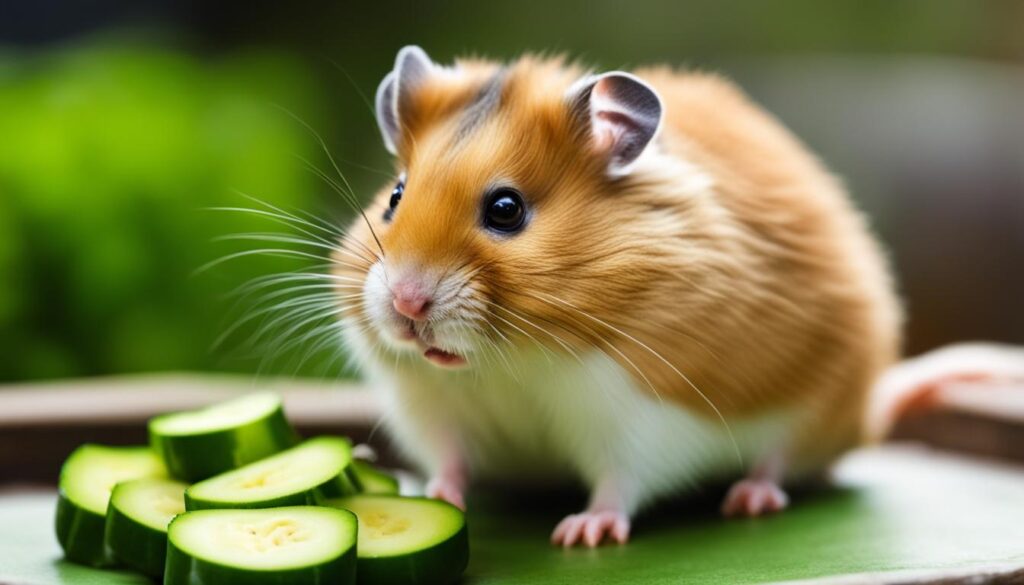
Introducing Zucchini to Your Hamster’s Diet
When it comes to introducing zucchini to your hamster’s diet, it’s important to start small. Begin with a piece of zucchini no longer than an inch in size. This allows your furry friend to familiarize themselves with the new food without overwhelming their digestive system.
Place the zucchini in an area away from your hamster’s regular food to prevent spoilage. This helps maintain the freshness and quality of the zucchini, ensuring that it remains a healthy and safe snack option.
Allow your hamster to approach the zucchini at their own pace. Every hamster is unique, and some may take longer to warm up to new foods than others. By giving them the freedom to explore and try the zucchini on their terms, you’re creating a positive and stress-free eating experience.
As you introduce zucchini to your hamster’s diet, it’s essential to monitor their reaction closely. Watch for any signs of an upset stomach, such as watery stool, within the next 12 hours. If your hamster experiences any digestive issues, it’s best to refrain from feeding them any new food and consult a veterinarian if the condition does not improve.
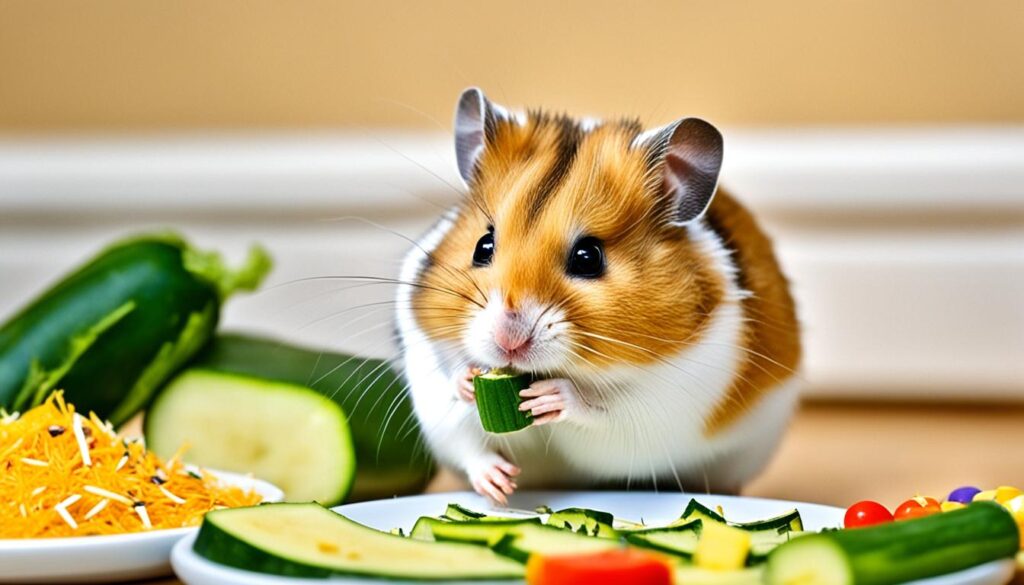
Our Top Tips for Introducing Zucchini:
- Start with a small piece of zucchini, no longer than an inch in size.
- Place the zucchini away from your hamster’s regular food to prevent spoilage.
- Allow your hamster to approach the zucchini at their own pace.
- Monitor your hamster for any signs of an upset stomach within the next 12 hours.
- Consult a veterinarian if your hamster experiences any digestive issues.
Remember, a gradual and cautious approach is key when introducing new foods to your hamster’s diet. By following these feeding guidelines, you can ensure a smooth transition and provide your furry friend with a variety of nutritious snack options.
Safety Precautions and Tips for Feeding Zucchini to Your Hamster
When it comes to feeding zucchini to your hamster, there are a few safety precautions and tips to keep in mind. By following these guidelines, you can ensure that your furry friend stays healthy and happy.
- Discard any remaining zucchini pieces: After a few hours, it’s important to remove any uneaten zucchini from your hamster’s cage. Fresh vegetables, including zucchini, can spoil if left out at room temperature for too long. By discarding any leftovers, you can prevent your hamster from consuming spoiled food.
- Check for hidden zucchini pieces: Hamsters have a habit of hoarding food in their cages. It’s essential to check for any hidden zucchini pieces that your hamster may have stored away. These hidden pieces can spoil and may cause digestive issues if consumed later.
- Feed washed, raw zucchini: Before giving zucchini to your hamster, make sure to wash it thoroughly. This removes any dirt or pesticides that may be present on the surface. Additionally, feeding raw zucchini ensures maximum freshness and nutrient content for your hamster.
Following these safety precautions and tips will help you provide a safe and enjoyable zucchini snacking experience for your hamster.
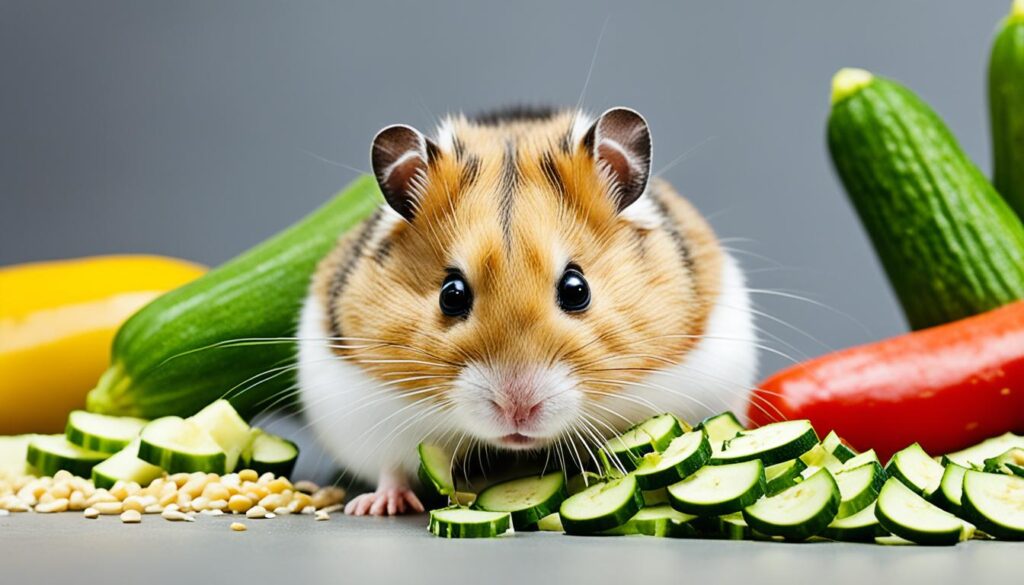
Zucchini as a Nutritious and Low-Calorie Snack for Hamsters
Zucchini is a fantastic option for hamsters looking for a nutritious and low-calorie snack. Not only is it packed with essential vitamins and antioxidants, but it also contains dietary fiber, making it great for hamsters’ overall health and well-being.
When introducing zucchini into your hamster’s diet, it is essential to do so slowly and in appropriate portions. Remember, zucchini should never be the sole source of nutrition for hamsters. Instead, it should be given as a supplemental snack to ensure a well-balanced hamster diet.
Hamsters can benefit from the various nutrients found in zucchini, including vitamins A, C, and K. These vitamins contribute to their overall immune system, vision health, and bone strength. Additionally, the dietary fiber in zucchini aids in proper digestion and can help prevent constipation in hamsters.
One of the remarkable aspects of zucchini is that it is a low-calorie food. This means that hamsters can enjoy this tasty snack without worrying about excessive calorie intake, which can lead to obesity or other health issues. It’s a guilt-free treat for our furry friends!
Zucchini is a nutritious and low-calorie snack for hamsters that provides them with essential vitamins, antioxidants, and dietary fiber. Not only can it contribute to their overall health and well-being, but it also adds a delicious variety to their diet.
Remember, moderation is key when feeding zucchini to your hamster. It should only be given as a supplemental snack a few times a week, alongside their regular hamster pellets. This ensures that they receive a well-balanced and nutritious diet, allowing them to thrive.
Benefits of Zucchini for Hamsters:
- Rich in antioxidants that support overall health
- Packed with vitamins A, C, and K for immune function and vision health
- Dietary fiber aids in digestion and prevents constipation
- Low-calorie snack that helps maintain a healthy weight
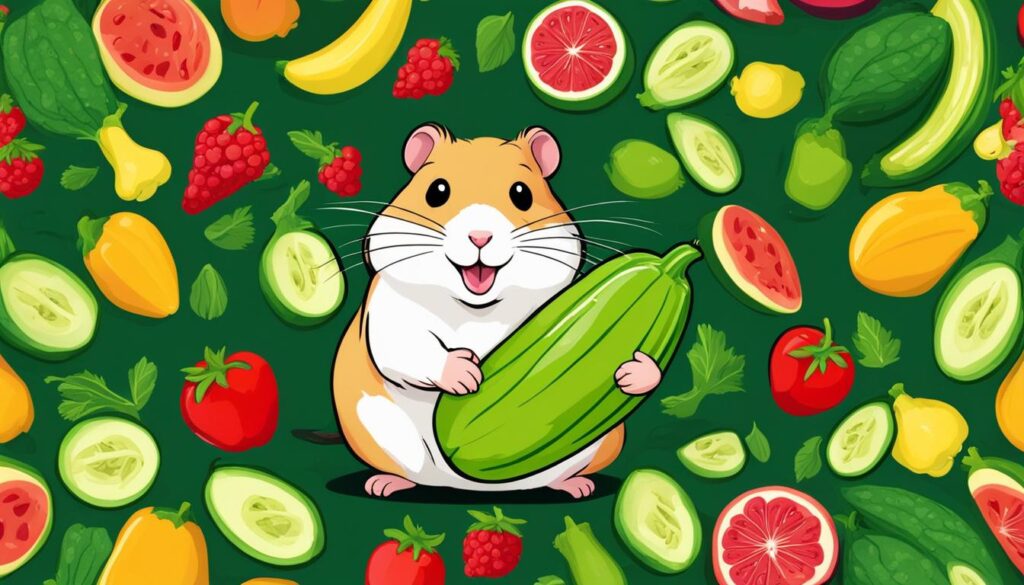
By including zucchini as part of your hamster’s diet, you are providing them with a nutritious snack that offers a range of benefits. Remember to introduce it gradually, monitor your hamster’s reaction, and always prioritize a well-balanced diet.
Conclusion
After exploring the benefits and considerations of adding zucchini to a hamster’s diet, we can conclude that zucchini can be a safe and enjoyable snack for hamsters. Its low calorie content, rich nutrient profile, and various health benefits make it a nutritious addition to their diet. However, it is important to remember that zucchini should be given in moderation and as part of a well-balanced diet that includes high-quality pellets.
By following the recommended feeding guidelines and introducing zucchini gradually, we can ensure that our hamsters safely enjoy this nutritious snack. Monitor your hamster’s reaction to new foods, including zucchini, and consult a veterinarian if any digestive issues arise. Remember to prioritize the majority of their diet with high-quality pellets to meet their nutritional needs.
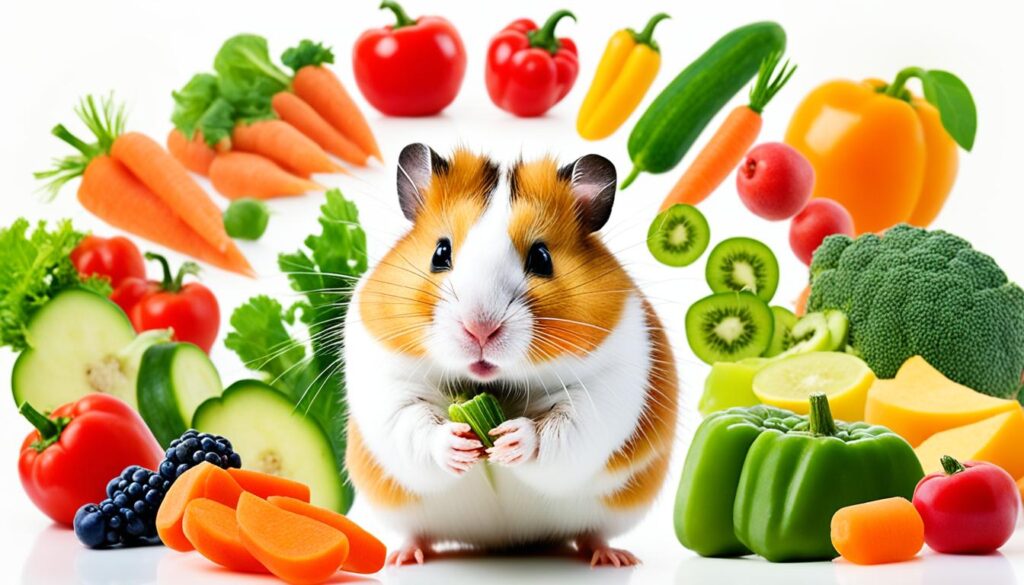
“Zucchini can be a safe and enjoyable addition to a hamster’s diet.”
We hope this guide has provided you with valuable insights on incorporating zucchini into your hamster’s diet. By offering this nutritious and low-calorie snack, you can enhance your hamster’s overall health and well-being. Remember to always provide a well-balanced diet and consult with a veterinarian for further guidance. Here’s to happy and healthy hamsters!
“Feed your hamster a well-balanced diet, including zucchini in moderation, for a happy and healthy pet.”
Conclusion
In conclusion, hamsters can safely enjoy zucchini as part of their nutritious diet. Zucchini provides a range of health benefits, including essential vitamins, antioxidants, and dietary fiber. When feeding zucchini to your hamster, it is crucial to follow recommended feeding guidelines and introduce it gradually to prevent any digestive issues. Remember that zucchini should be offered as a supplemental snack, not as the main source of nutrition.
By including zucchini in moderation, you can provide your hamster with a delicious and healthy treat. Always monitor your hamster’s reaction to new foods and consult a veterinarian if you have any concerns. With proper care and attention, you can ensure that your hamster enjoys the many advantages of zucchini as a safe snack option.
So go ahead and offer your hamster some zucchini every now and then, knowing that it is a safe and beneficial addition to their diet. Your furry friend will surely appreciate the tasty and nutritious snack!

